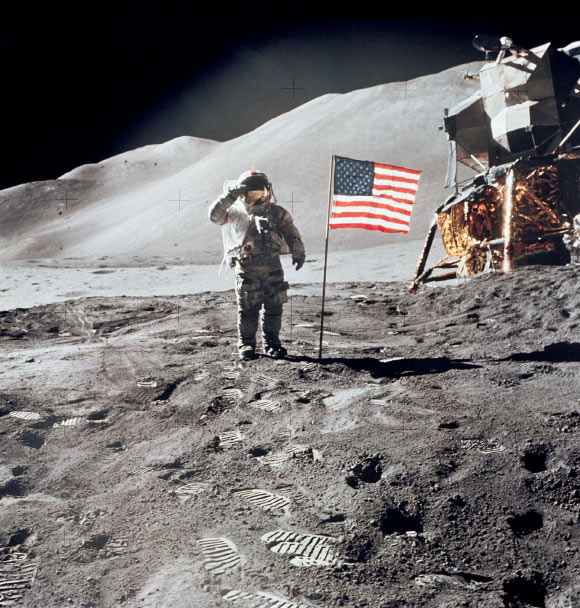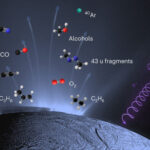In a paper published in the journal Nature Geoscience, Kansas Geological Survey researcher Justin Holcomb and his colleagues argue the new epoch may have dawned in 1959, thanks to the Soviet unmanned spacecraft Luna 2.
Astronaut David R. Scott, commander, gives a military salute while standing beside the deployed United States flag during the Apollo 15 lunar surface extravehicular activity (EVA) at the Hadley-Apennine landing site. The flag was deployed toward the end of EVA-2. The Lunar Module, ‘Falcon,’ is partially visible on the right. Hadley Delta in the background rises approximately 4,000 m (about 13,124 feet) above the plain. The base of the mountain is approximately 5 km (about three statue miles) away. This photograph was taken by astronaut James B. Irwin, lunar module pilot. While astronauts Scott and Irwin descended in the Lunar Module to explore the Moon, astronaut Alfred M. Worden, command module pilot, remained in lunar orbit in the Command and Service Modules. Image credit: NASA / JSC.
Homo sapiens first appeared in Africa around 300,000 years ago, and after a series of fits and starts, we successfully populated every continent — except for Antarctica – by approximately 16,000 years ago.
To track and correlate these dispersals, archaeologists study the material remains left behind by humans, including artifacts, features, and art.
One result of the long evolutionary journey is that our species has re-ordered life on Earth, altered the atmosphere and oceans, and become the primary driver of geomorphic change.
As a result, some scientists have argued that we should designate a geological epoch capturing our impact on the Earth — an ‘age of humans’ called the Anthropocene.
Currently, we are undergoing our next major range expansion: the peopling of our Solar System.
But rather than stone tools and hearths, we leave behind human footprints, rovers and rover tracks, landers, and various scientific equipment.
The human imprint began in 1959 when Luna 2 impacted east of Mare Imbrium on the Moon, producing the first human-made crater.
Since this event, humans have caused surface disturbances in at least 58 additional locations on the lunar surface.
As we enter the next space race, one characterized by private companies offering access via space tourism and plans for industrial mining, Dr. Holcomb and co-authors argue that it is time to discuss whether Earth’s Moon has also entered its own ‘age of humans’ — a Lunar Anthropocene.
“The idea is much the same as the discussion of the Anthropocene on Earth — the exploration of how much humans have impacted our planet,” Dr. Holcomb said.
“The consensus is on Earth the Anthropocene began at some point in the past, whether hundreds of thousands of years ago or in the 1950s.”
“Similarly, on the Moon, we argue the Lunar Anthropocene already has commenced, but we want to prevent massive damage or a delay of its recognition until we can measure a significant lunar halo caused by human activities, which would be too late.”
The researchers hope the Lunar Anthropocene concept might help dispel the myth that the Moon is an unchanging environment, barely impacted by humanity.
“Cultural processes are starting to outstrip the natural background of geological processes on the Moon,” Dr. Holcomb said.
“These processes involve moving sediments, which we refer to as ‘regolith,’ on the Moon.”
“Typically, these processes include meteoroid impacts and mass movement events, among others. However, when we consider the impact of rovers, landers and human movement, they significantly disturb the regolith.”
“In the context of the new space race, the lunar landscape will be entirely different in 50 years.”
“Multiple countries will be present, leading to numerous challenges.”
“Our goal is to dispel the lunar-static myth and emphasize the importance of our impact, not only in the past but ongoing and in the future.”
“We aim to initiate discussions about our impact on the lunar surface before it’s too late.”
While many outdoors enthusiasts are familiar with ‘Leave No Trace’ principles, they don’t seem to exist on the Moon.
According to the authors, refuse from human missions to the Moon includes discarded and abandoned spacecraft components, bags of human excreta, scientific equipment, and other objects (e.g., flags, golf balls, photographs, religious texts).
“We know that while the Moon does not have an atmosphere or magnetosphere, it does have a delicate exosphere composed of dust and gas, as well as ice inside permanently shadowed areas, and both are susceptible to exhaust gas propagation,” they said.
“Future missions must consider mitigating deleterious effects on lunar environments.”
While the scientists want to use the Lunar Anthropocene to highlight the potential for humanity’s potential negative environmental impact to the Moon, they also hope to call attention to the vulnerability of lunar sites with historical and anthropological value, which currently have no legal or policy protections against disturbance.
“A recurring theme in our work is the significance of lunar material and footprints on the Moon as valuable resources, akin to an archaeological record that we’re committed to preserving,” Dr. Holcomb said.
“The concept of a Lunar Anthropocene aims to raise awareness and contemplation regarding our impact on the lunar surface, as well as our influence on the preservation of historical artifacts.”
“This field of ‘space heritage’ would aim to preserve or catalog items such as rovers, flags, golf balls and footprints on the Moon’s surface.”
“As archaeologists, we perceive footprints on the Moon as an extension of humanity’s journey out of Africa, a pivotal milestone in our species’ existence.”
“These imprints are intertwined with the overarching narrative of evolution.”
“It’s within this framework we seek to capture the interest of not only planetary scientists but also archaeologists and anthropologists who may not typically engage in discussions about planetary science.”
_____
J.A. Holcomb et al. The case for a lunar anthropocene. Nat. Geosci, published online December 8, 2023; doi: 10.1038/s41561-023-01347-4




